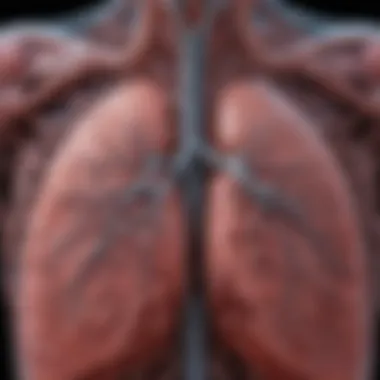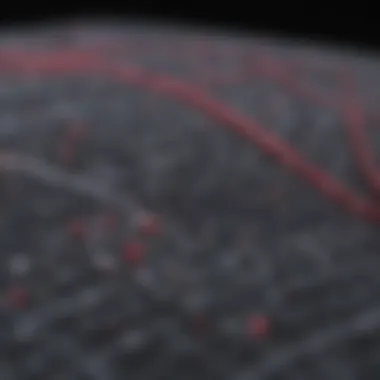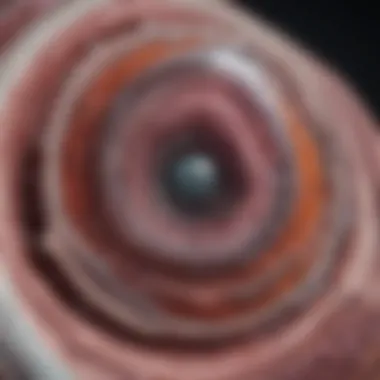Understanding Lung Shunt Fraction in Yttrium-90 Radioembolization


Intro
Yttrium-90 (Y90) radioembolization is an innovative treatment for hepatic tumors, utilizing radioactive microspheres to target cancerous cells. A significant aspect of this therapy is the lung shunt fraction (LSF), which measures the portion of administered radioactivity that potentially reaches the lungs instead of the target liver tissue. Understanding LSF is crucial for treatment planning, patient safety, and overall outcomes.
In this article, we will explore the key concepts related to lung shunt fraction, methods of calculation, and the latest trends in research concerning Y90 radioembolization. We will also examine the implications of high LSF values and discuss advancements in imaging techniques that support clinical decision-making. Through this comprehensive analysis, healthcare professionals and informed readers will gain a deeper understanding of the role LSF plays in optimizing therapeutic success.
Key Concepts
Definition of the Main Idea
The lung shunt fraction (LSF) is defined as the percentage of the administered radioactivity that inadvertently travels to the lungs rather than being concentrated in the liver. It is an important parameter as elevated LSF levels can lead to pulmonary complications. Calculating an accurate LSF assists in tailoring treatment plans, thereby minimizing risks for patients.
Overview of Scientific Principles
Yttrium-90 radioembolization employs microspheres that contain the radioactive isotope Yttrium-90. These microspheres are injected into the blood vessels supplying the liver tumors. The process hinges on the concept of selective internal radiation therapy, which aims to maximize localized radiation exposure while limiting it to surrounding healthy tissue. The effectiveness of this treatment relies on a proper understanding of physiological factors that influence LSF, including the vascular anatomy of the patient and the distribution of blood flow.
Current Research Trends
Recent Studies and Findings
Ongoing research has highlighted the importance of accurately measuring LSF prior to Y90 radioembolization. Recent studies suggest advanced imaging techniques greatly enhance the precision of LSF calculations. Techniques such as single-photon emission computed tomography (SPECT) and computed tomography (CT) now allow for more detailed analysis of blood flow patterns.
Significant Breakthroughs in the Field
One major breakthrough is the integration of artificial intelligence algorithms in the interpretation of imaging data. These algorithms reduce human error and improve the precision of LSF assessments. Furthermore, studies have shown that modifying treatment approaches based on LSF can significantly improve patient outcomes and reduce the incidence of adverse effects.
The evolving landscape of Y90 radioembolization emphasizes the need for a multidisciplinary approach, incorporating expertise from various fields to optimize treatment strategies and improve patient care.
The evolving landscape of Y90 radioembolization emphasizes the need for a multidisciplinary approach, incorporating expertise from various fields to optimize treatment strategies and improve patient care.
Foreword to Yttrium-90 Radioembolization
Yttrium-90 radioembolization is a cutting-edge treatment option used in the management of hepatic tumors. Its significance lies in the ability to selectively deliver radiation directly to tumor sites within the liver. This focused approach minimizes damage to surrounding healthy tissues, which is a common concern with conventional radiation therapies. Furthermore, as this treatment gains traction in clinical practices, understanding the various components involved becomes essential for both practitioners and patients alike.
One crucial aspect of Yttrium-90 therapy is the concept of lung shunt fraction (LSF). The LSF quantifies the proportion of administered microspheres that inadvertently reaches the lungs instead of the intended hepatic targets. This can have serious implications for patient safety and treatment outcomes. A clear frame of reference to LSF and its calculation is vital for optimizing therapy and minimizing risks.
Additionally, evaluating and managing LSF allows healthcare providers to make informed decisions regarding treatment planning. This article will delve into detailed discussions about the implications of LSF in Yttrium-90 radioembolization, its calculation methods, associated risks, and potential strategies for management. Understanding these elements can ultimately contribute to better patient prognoses and refine interdisciplinary approaches in oncology.
In summary, grasping how Yttrium-90 radioembolization functions and its relation to lung shunt fraction is imperative not only for medical professionals but also for students and researchers engaged in the field of oncology. This foundational knowledge forms the basis of effective and safe applications of advanced treatment modalities.
Defining Lung Shunt Fraction
Understanding the lung shunt fraction (LSF) is crucial in the context of Yttrium-90 (Y90) radioembolization. This concept plays a vital role in treatment planning for patients undergoing this therapy. An accurate understanding of LSF helps practitioners mitigate risks and optimize outcomes for patients suffering from hepatic tumors. The inclusion of this topic in the article emphasizes its significance, considering both patient safety and treatment efficacy.
Overview of Lung Shunt Fraction
The lung shunt fraction refers to the percentage of the administered therapeutic dose of radioembolization that reaches the lungs as opposed to the intended target in the liver. When considering Y90 radioembolization, a precise calculation of LSF becomes essential. This calculation is typically determined by analyzing the distribution of microspheres in the body following the administration of the radioisotope.
In practice, a normal LSF is generally under 10%. An increase in LSF values indicates a higher percentage of microspheres being diverted to the lungs. This diversion can result in significant pulmonary toxicity. Therefore, it is paramount for healthcare professionals to assess this fraction carefully.
Clinical Relevance of LSF
The clinical implications of LSF are manifold. High LSF values can lead to serious consequences. For instance, the patient may experience complications like radiation pneumonitis. This condition can manifest as shortness of breath, coughing, and even pulmonary fibrosis if not addressed.
Assessing LSF is not merely an academic exercise; it has practical applications in treatment planning. If the LSF is deemed high, an adjustment in the approach may be necessary. Options include:


- Modifying the dosage of Y90;
- Selecting alternative therapy options;
- Implementing additional imaging studies for better assessment.
Assessing LSF not only guides treatment decisions but also helps in communication among multidisciplinary teams. Proper interpretation enables oncologists, radiologists, and other healthcare providers to devise a comprehensive strategy tailored to each patient's needs.
A thorough understanding of LSF is integral to achieving optimal outcomes in Y90 radioembolization therapies.
A thorough understanding of LSF is integral to achieving optimal outcomes in Y90 radioembolization therapies.
Calculating Lung Shunt Fraction
Calculating lung shunt fraction (LSF) is essential in the context of Yttrium-90 radioembolization. This measurement can inform clinicians about how much of the administered microspheres are directed to the lung rather than the target tumor. An accurate calculation of LSF plays a prominent role in treatment planning, as it estimates the risk of pulmonary complications and ensures effective dosage for the intended area. By identifying potential risks through calculation, healthcare providers can tailor interventions accordingly, thereby optimizing patient outcomes.
Techniques for Measurement
Microsphere Distribution
Microsphere distribution is a critical element in calculating lung shunt fraction. This technique evaluates how particles injected into the hepatic artery distribute throughout the body. The key characteristic of microsphere distribution is its precision in tracking particle flow. This detail makes it a beneficial choice in assessing LSF.
The unique feature of this method lies in its ability to provide real-time insights into where the microspheres travel. One advantage is its detailed mapping, which can help prevent excess radiation exposure to the lungs. However, this method can be complex, requiring specialized equipment and expertise, which may limit its accessibility in some clinical settings.
Imaging Methods
Imaging methods are also significant in measuring lung shunt fraction. Techniques like computed tomography (CT) and magnetic resonance imaging (MRI) offer detailed visualization of the microsphere placement. The key characteristic of imaging methods is their non-invasive nature, allowing for thorough monitoring without additional procedural risks.
The unique feature of imaging methods is their capability to visualize the anatomy and blood flow dynamics in real time. Among the advantages, they provide clear, comprehensive views of potential distribution patterns. However, they may sometimes require contrast agents that can have implications for patient safety, especially in those with compromised renal function.
Interpreting LSF Values
Interpreting LSF values is an integral part of understanding the overall impact of these measurements. A high LSF value may indicate an elevated risk of pulmonary complications, such as pulmonary toxicity and other adverse effects. Consequently, healthcare professionals must evaluate these values in conjunction with other clinical factors, thus ensuring a comprehensive treatment planning process. As the field progresses, a thorough understanding of LSF values will be invaluable in enhancing patient safety and optimizing treatment efficacy.
Implications of High Lung Shunt Fraction
An elevated lung shunt fraction (LSF) during Yttrium-90 radioembolization carries significant implications for patient safety and treatment efficacy. The LSF indicates the percentage of microspheres administered that travel to the lungs rather than the targeted liver tumors. A high LSF can result in increased pulmonary radiation exposure, leading to a higher risk of adverse effects. Understanding these implications is crucial for healthcare professionals in making informed decisions regarding treatment plans.
Risks Associated with Elevated LSF
Pulmonary Toxicity
Pulmonary toxicity is a critical concern related to high LSF in patients undergoing Yttrium-90 radioembolization. When the radioactive microspheres enter the lungs, they can cause damage to healthy lung tissue, leading to complications such as pneumonitis or pulmonary fibrosis. These conditions may manifest as respiratory symptoms and can significantly hinder a patient's quality of life.
A key characteristic of pulmonary toxicity is its dose-dependent nature. The risk escalates with increased LSF values, highlighting the need for careful assessment during treatment planning. If left unmonitored, pulmonary toxicity can be a detrimental side effect, making it important for clinicians to implement effective monitoring strategies post-treatment and, if necessary, develop protocols to mitigate this risk.
Complications in Treatment
Complications arising from elevated LSF are critical to understand within the context of Yttrium-90 radioembolization. These complications may include acute respiratory distress or significant lung injury, leading to prolonged hospital stays and additional medical interventions. Such issues necessitate thorough pre-procedural evaluations and risk assessments to ensure safe procedures.
A defining aspect of complications in treatment relates to their unpredictability. Patients with similar LSF values may experience varying degrees of complications, complicating treatment plans and patient expectations. Awareness of potential complications can enable healthcare teams to develop customized strategies focusing on patient safety and treatment success.
Management Strategies
Effective management of high LSF is essential for optimizing patient outcomes during Yttrium-90 radioembolization. Strategies may involve a combination of imaging methods, careful planning, and interdisciplinary collaboration among healthcare professionals.
To minimize risks, it may be beneficial to consider altering microsphere dosage, utilizing advanced imaging technologies to better assess lung shunt fraction values, or adapting treatment regimens based on patient-specific anatomical and physiological data. Furthermore, ongoing research continues to yield insights into innovative solutions for managing elevated LSF, which can lead to improved patient safety and treatment efficacy.
Healthcare teams should consistently evaluate and refine their management strategies, ensuring all aspects of high LSF implications are addressed and optimized for each individual's care.
Advancements in Imaging Techniques


In the context of Yttrium-90 radioembolization, advancements in imaging techniques play a critical role. Such techniques are essential for accurately assessing lung shunt fraction (LSF) and thereby optimizing treatment strategies. Enhanced imaging modalities provide detailed insights into the vascular structures and potential shunting of radioisotopes, which are vital for predicting patient outcomes.
Role of CT and MRI
Computed Tomography (CT) and Magnetic Resonance Imaging (MRI) are foundational in evaluating patients for Yttrium-90 radioembolization. CT is particularly valuable due to its high spatial resolution and rapid acquisition times. It enables visualization of hepatic tumors and their proximity to important vascular structures, which helps in treatment planning. The role of contrast-enhanced CT scans is to identify the presence and degree of lung shunting before the procedure.
MRI, on the other hand, provides excellent soft tissue contrast and can reveal additional anatomical details that may not be clear on CT. This is particularly useful in patients with complex vascular anatomy or those with previous hepatic interventions. By utilizing both imaging modalities, clinicians gain a comprehensive view that supports accurate LSF calculation.
Emerging Technologies
PET Imaging
Positron Emission Tomography (PET) imaging offers specific insights into metabolic activity and can assist in optimizing the use of Yttrium-90. A major characteristic of PET is its ability to visualize tracer distribution and uptake at the cellular level. This allows for a better understanding of tumor viability and the surrounding tissue response post-treatment.
PET imaging is increasingly favored because of its precision and depth of information. One unique feature of PET is its capability to integrate with CT, enhancing the anatomical context of the metabolic data presented. Although PET requires specialized radiotracers and may increase procedural costs, the insights it provides can be invaluable in assessing treatment efficacy and adjusting follow-up care.
Spectral Imaging
Spectral imaging is an innovative technique that allows for the characterization of materials through multiple wavelengths. This imaging approach enhances the detection and quantification of radioisotopes in various tissues, improving the assessment of LSF. One of the key strengths of spectral imaging is its ability to differentiate between different types of tissues and their respective perfusion characteristics.
The unique feature of spectral imaging lies in its sensitivity to subtle differences in radiographic data, which could be beneficial in identifying patients at risk from high LSF. However, the technology may require advanced software and interpretation skills, which could pose challenges in routine clinical settings. Despite these challenges, emerging imaging technologies like spectral imaging are gaining traction as they promise clearer insights into treatment dynamics.
Multidisciplinary Approaches in Treatment Planning
In the context of Yttrium-90 radioembolization, a multidisciplinary approach to treatment planning is essential. This method involves the collaboration of diverse healthcare specialists, including radiologists, medical oncologists, interventional radiologists, and nuclear medicine physicians. The integration of various skill sets enhances cancer treatment outcomes and allows for more comprehensive patient management.
Benefits of a Multidisciplinary Approach
- Holistic Patient Assessment: By engaging multiple specialists, a thorough evaluation can occur. Each professional brings specific insights, contributing to a well-rounded understanding of the patient's condition.
- Tailored Treatment Plans: Diverse expertise allows for the development of highly personalized strategies. Treatment can be adjusted based on individual patient characteristics, optimizing efficacy.
- Enhanced Communication: Multidisciplinary teams promote better information sharing. This leads to fewer misunderstandings and mistakes, ensuring that all parties involved are aligned in their objectives and approaches.
Multidisciplinary collaboration in treatment planning can lead to improved patient experiences and outcomes in complex therapies like radioembolization.
Multidisciplinary collaboration in treatment planning can lead to improved patient experiences and outcomes in complex therapies like radioembolization.
Collaboration Between Specialties
Collaboration among various medical specialties is pivotal in ensuring effective Yttrium-90 radioembolization. Each specialist plays a critical role in both the treatment planning and execution phases. For example, radiologists focus on imaging and diagnosis, while interventional radiologists perform the actual procedures. Their combined efforts lead to a more streamlined process for the patient.
Communication must be intentional. Regular multidisciplinary meetings provide a platform where specialists discuss patient cases and share insights. Such discussions enable more informed decision-making, which ultimately enhances the quality of care provided.
Patient-Centric Treatment Plans
A patient-centric treatment plan places the needs and preferences of the patient at the forefront. This approach ensures that patients are not merely passive recipients of care but active participants in their treatment journey. In Yttrium-90 radioembolization, establishing a patient-centered plan involves several key factors:
- Informed Consent: Patients should be well-informed about the procedures, potential benefits, and risks associated with radioembolization. Clear communication from the healthcare team is necessary.
- Personal Goals: Understanding what the patient hopes to achieve from treatment plays a crucial role. These goals can vary and should influence the planning process.
- Follow-Up Care: Post-treatment support is vital for managing any side effects and monitoring progress. A robust follow-up care program should be established as part of the treatment plan, integrating input from all relevant specialists.
Implementing patient-centric strategies can improve satisfaction and adherence, ultimately leading to better health outcomes.
Clinical Outcomes and Patient Prognosis
The understanding of clinical outcomes and patient prognosis in the context of Yttrium-90 radioembolization is crucial for both practitioners and patients. These factors not only influence the decision-making processes prior to treatment, but also define the expectations and longer-term management of patients. Given the complexities involved in hepatic tumor treatment, it is imperative to link lung shunt fraction (LSF) levels to the anticipated outcomes. A well-established relationship between high LSF and adverse clinical consequences can help clinicians tailor their approaches accordingly.
Evaluating Success Rates
Success rates for Yttrium-90 radioembolization are typically assessed through various parameters. One of the primary metrics is tumor response, which can be categorized via imaging studies post-treatment. Common imaging techniques include CT, MRI, and PET scans. A reduction in tumor size or viability is often indicative of treatment efficacy.


Another key metric is overall survival rates. The survival probability varies based on multiple factors, including initial tumor burden, liver function, and the patient’s overall health. It is essential to consider LSF in this evaluation. High LSF values may correlate with increased pulmonary complications, potentially affecting overall survival.
Key points to consider while evaluating success rates include:
- Time to response measurement (how long it takes for the tumor to respond)
- Comparison with historical data from similar patient cohorts
- Consideration of the tumor type and location
- Assessment of functional liver reserve, particularly for cirrhotic patients.
"Understanding the association between LSF and treatment response is vital for optimizing outcomes in Yttrium-90 therapy."
"Understanding the association between LSF and treatment response is vital for optimizing outcomes in Yttrium-90 therapy."
Long-Term Follow-Up Studies
Long-term follow-up studies serve an important role in the evaluation of clinical outcomes following Yttrium-90 radioembolization. These studies can illustrate trends over time, such as recurrence rates and emergence of new tumors. They also permit the examination of late toxicity, thus contributing to our understanding of the treatment's safety profile.
Such follow-ups commonly analyze:
- Patient health status over extended periods.
- The incidence of delayed complications, particularly pulmonary issues related to high LSF.
- Quality of life assessments post-treatment.
By incorporating patient perspectives and clinical data, clinicians can adjust treatment strategies and improve future interventions. This patient-centric approach underpins the ethos of modern cancer therapy, ensuring a comprehensive evaluation that goes beyond initial treatment success.
Future Directions in Y90 Research
Yttrium-90 radioembolization has established itself as a pivotal treatment modality for liver tumors. As research continues, the focus is shifting toward refining this technique and enhancing its efficacy. Future directions in Y90 research are vital to address existing challenges and optimize patient outcomes. They encapsulate the need for ongoing innovation, improved methodologies, and a broader integration of technologies.
Innovations in Treatment Techniques
Innovative treatment techniques in Y90 radioembolization are essential to maximize therapeutic benefits while minimizing risks. New approaches include the development of more effective microsphere delivery systems. These systems can offer enhanced targeting of the tumor while limiting collateral damage to healthy tissue.
A significant advancement is the application of personalized dosimetry. This approach considers individual patient anatomy and tumor characteristics, allowing for tailored treatment plans. By customizing the dosage and distribution of microspheres, healthcare providers can achieve better control over treatment outcomes.
In addition, researchers are exploring the use of combination therapies that integrate Y90 with other modalities. For instance, combining Y90 with immunotherapy or systemic treatments may yield synergistic effects. These strategies can help to tackle tumor heterogeneity and improve overall survival rates for patients.
Potential for Combined Modalities
The potential for combined modalities with Yttrium-90 offers a promising frontier in oncology. Integrating different treatment strategies can create a more effective therapeutic regimen. For instance, combining Y90 with targeted therapies or chemotherapeutic agents allows for a comprehensive attack on tumors.
This approach has several advantages:
- Enhanced Efficacy: The combination can tackle different pathways of tumor growth and resistance.
- Reduced Toxicity: By using lower doses of each treatment, the overall toxicity might decrease.
- Broader Precision: It allows physicians to fine-tune the treatment based on the tumor's response.
Further research is also delving into the role of radiogenomics, where genetic profiling of tumors informs the selection of combined therapies. Such precision medicine approaches can lead to highly individualized and effective treatment strategies.
"The integration of multiple treatment modalities may redefine the standards of care in oncology, particularly for challenging cases like liver tumors."
"The integration of multiple treatment modalities may redefine the standards of care in oncology, particularly for challenging cases like liver tumors."
End
The conclusion of this article encapsulates the vital role that lung shunt fraction (LSF) plays in Yttrium-90 (Y90) radioembolization and treatment strategies. Understanding LSF is essential for optimizing patient outcomes, determining the feasibility of radioembolization, and minimizing potential complications associated with treatment. The assessment of LSF helps healthcare professionals gauge the distribution of microspheres during therapy, which can directly impact the efficacy and safety of treatment.
Crucially, the implications of high LSF are multi-faceted. Not only does it pose risks for pulmonary toxicity, but it can also lead to complications that affect overall treatment success. Therefore, careful evaluation and calculation of LSF should be standard practice in treatment planning. By integrating advanced imaging techniques, clinicians could obtain a more precise measurement of LSF, resulting in tailored and effective interventions based on individual patient profiles. This careful approach enhances the therapeutic ratio, balancing the benefits while reducing potential risks.
With all these considerations in mind, the summarized findings set the stage for future research in this dynamic field.
Summary of Key Findings
- Significance of LSF: LSF serves as a critical metric in evaluating the distribution of radiopharmaceuticals in liver radioembolization treatments.
- High LSF Risks: It presents significant risks, including pulmonary toxicity, which clinicians must manage vigilantly.
- Calculation Best Practices: Understanding techniques for calculating LSF can lead to improved patient outcomes.
- Advancements in Imaging: Emerging imaging technologies enhance the accuracy of LSF measurements and improves treatment planning.
Call for Continued Research
Future research directions should focus on refining the methodologies for measuring and interpreting LSF. Innovations in imaging technology, like the integration of PET and spectral imaging, hold promise for increased accuracy and safety. Moreover, additional studies on the correlation between LSF values and long-term patient outcomes could inform better treatment decisions.
Collaboration amongst multidisciplinary teams will be essential as they explore combined modalities in treatment planning. There remains a stark need for larger-scale clinical trials to validate findings related to LSF and its implications on therapy efficacy. Continued efforts must build on the groundwork laid in this article to fully understand LSF’s impact on patient outcomes and safety in Y90 radioembolization.







